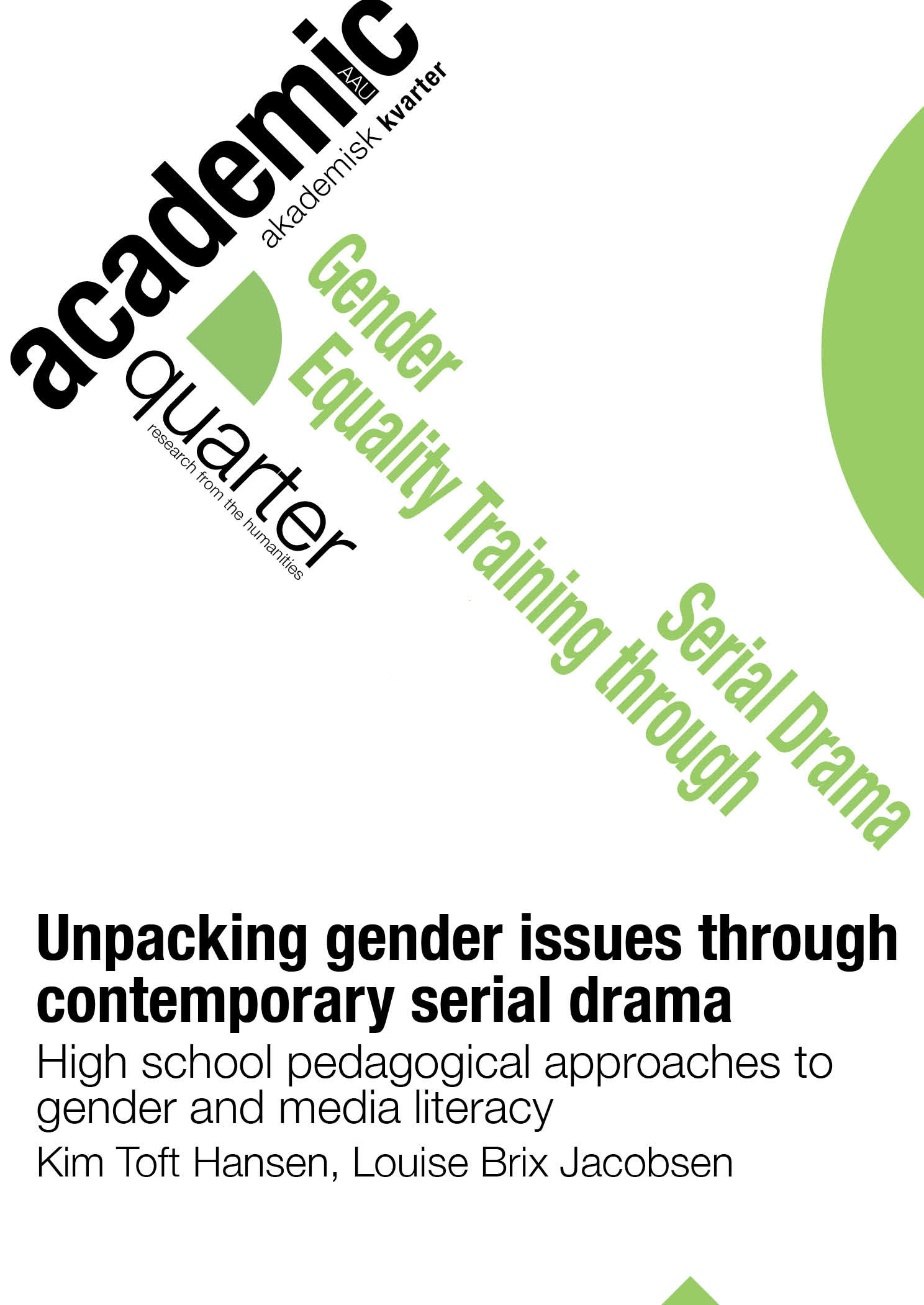Abstract | Abstract
This contribution explores the pedagogical potential of using one scene from one serial drama to teach gender issues in a high school context. The contribution is a text-based argument with an overall media literacy approach to teaching gender issues. As pedagogical examples, we present two different series – Euphoria (HBO 2019-) and Rita (TV2/Netflix 2012-20) – through two individual video excerpts from the series. These scenes have been carefully selected to highlight how specific gender issues may be scrutinised from just one brief sequence. The scene from Euphoria provides an opportunity to analyse toxic masculinity, while the scene from Rita presents a perspective that we identify as banal gender bending. In conclusion, we highlight how this approach not only provides high school teachers with an opportune way to locate usable excerpts as teaching material; this specific approach also provides an occasion for teachers to turn the classroom around and facilitate students’ own search for usable excerpts in and creative appropriation of serial drama.
Referencer
Arlien-Søborg, Line. 2018. “Råd, tips og tricks i det praktiske arbejde med mediefag.” In Fagdidaktik i mediefag, edited by Mimi Olsen. Frydenlund.
Barthes, Roland. 1964. “Rhétorique de l’image”. Communications 4: 40-51. https://doi.org/10.3406/comm.1964.1027
Bem, S. L. (1974). The measurement of psychological androgyny. Journal of Consulting and Clinical Psychology, 42: 155–162.
Billig, Michael. 1995. Banal Nationalism. London: SAGE.
Buckingham, David. 2003. Media Education: Literacy, Learning and Contemporary Culture. Polity Press.
Dunleavy, Trisha. 2017. Complex Serial Drama and Multiplatform Television. Routledge.
Hansen, Jens Jørgen. 2010. Læremiddellandskabet: Fra læremiddel til undervisning. Akademisk Forlag.
Hansen, Kim Toft. 2024a. “Euphoria and representations of toxic masculinity”. https://gemini.unilink.it/blog-entry-6/. Accessed 28 January 2025.
Hansen, Kim Toft. 2024b. “Rita and banal gender-bending”. https://gemini.unilink.it/blog-entry-10/. Accessed 24 October 2024.
Harrington, Carol. 2021. “What is “Toxic Masculinity” and Why Does it Matter?”. Men and Masculinities 24(2): 345-352. https://doi.org/10.1177/1097184X20943254.
Heller, Meredith. 2020. Queering Drag: Redefining the Discourse of Gender-Bending. Bloomington: Indiana University Press.
Husen, Michael. 1996. Det fælles tredje – om fællesskab og værdier i det pedagogiske arbejde. In Kultur & pædagogik, edited by Benedicta Pécseli. Socialpædagogisk Bibliotek. (English version available through this link: https://michaelhusen.dk/the-common-third/)
Jacobsen, Louise Brix and Kim Toft Hansen. 2024. “The GEMINI pedagogical triangle: From watching serial drama to teaching gender issues”. https://gemini.unilink.it/blog-entry-19/. Accessed 28 January 2025.
Koshy, Valsa. 2010. Action Research for Improving Educational Practice. SAGE Publications.
Macintosh, Paige. 2022. “Transgressive TV: Euphoria, HBO, and a New Trans Aesthetic.” Global Storytelling: Journal of Digital and Moving Images 2(1): 13-38. DOI: https://doi.org/10.3998/gs.1550.
Matud, M. Pilar. 2018. The Sex-Role Inventory. In Encyclopedia of Evolutionary Psychological Science, edited by Todd K. Shackelford and Viviana A. Weekes-Shackelford. Springer. DOI: https://doi.org/10.1007/978-3-319-16999-6_3394-1.
McCreadie, E. (2020). Utilising the ‘common third’ to enhance social work education. International Journal of Social Pedagogy, 9(1): 6. DOI: https://doi.org/10.14324/111.444.ijsp.2020.v9.x.006.
Mittell, Jason. 2015. Complex TV. The poetics of contemporary television storytelling. New York University Press.
Ministry of Teaching and Education. 2024. “Dansk A – stx, august 2017”. https://www.uvm.dk/-/media/filer/uvm/gym-laereplaner-2017/stx/dansk-a-stx-august-2017.pdf. Accessed 28 January 2025.
Mulvey, Laura. 1975. “Visual Pleasure and Narrative Cinema.” Screen, 16(3): 6–18, DOI: https://doi.org/10.1093/screen/16.3.6.
Olsen, Mimi. 2018. “Mediefag i gymnasiet.” I Fagdidaktik i mediefag, red. Mimi Olsen. Frydenlund.
Potter, W. James. 2008. Media Literacy. 4th Edition. SAGE Publications.
Prentice, Deborah A. and Erica Carranza. 2002. “What Women and Men Should Be, Shouldn’t Be, Are Allowed to Be, and Don’t Have to Be: The Contents of Prescriptive Gender Stereotypes.” Psychology of Women Quarterly, 26: 269-281. DOI: https://doi.org/10.1111/1471-6402.t01-1-00066.
Retsinformation 2024. ”Retningslinjer for universitetsuddannelser rettet mod undervisning i de gymnasiale uddannelser samt undervisning i gymnasiale fag i eux-forløb.” https://www.retsinformation.dk/eli/retsinfo/2018/9698. Accessed 24 October 2024.
Ryyänen, S., & Nivala, E. (2019). Inequality as a social pedagogical question. International Journal of Social Pedagogy, 7(1), 8. https://doi.org/10.14324/111.444.ijsp.2019.v7.1.008.
Série Series. 2013. “Rita / Case Study / Série Series 2013”. Moderated by Charline de Lépine. YouTube Video, Posted 26 February, posted by Série Series 2019. YouTube, 46:08. https://www.youtube.com/watch?v=Be0RtfMQ7b8.
Smith, Murray (1995). Engaging Characters: Fiction, Emotion, and the Cinema. Clarendon Press.
Spalletta, Marica, ed. 2024. Understanding Young Adults’ Perception and Detecting Teachers’ and Trainers’ Awareness. European Commission. https://vbn.aau.dk/ws/portalfiles/portal/762593573/D3.2-Final-report.pdf. Accessed 28 January 2025.
Weinreich, T. (1994). Skråt nedad: på vej mod en børnelitterær poetic. Copenhagen: Høst & Søn.

Dette værk er under følgende licens Creative Commons Navngivelse – Ikke-kommerciel – Ingen Bearbejdede Værker (by-nc-nd).
Copyright (c) 2025 Kim Toft Hansen, Louise Brix Jacobsen
